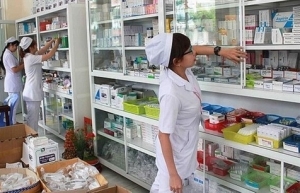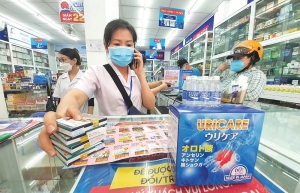The trends and driving factors in OTC and ETC drugs
OTC drugs are those that can be dispensed, retailed, and used without a prescription, from a Ministry of Health list, while prescribed drugs require a medical prescription due to the potential risks to the user’s health or life.
 |
| Ngo Thanh Hai, lawyer, LNT & Partners |
For a decade, there have been new regulations emphasising the selection of cost-effective drugs at hospitals, prioritising affordability. Consequently, businesses are focusing on developing the OTC channel to fortify their positions and ensure competitiveness in the market.
The existing scenario indicates a high potential for the growth of demand for OTC drugs, driven by current regulations, their effectiveness, and the evolving nature of OTC drug usage. According to SNS Insider, the global OTC drugs market reached a valuation of $166 billion in 2022, with a projected increase to $254 billion by 2030. This growth is expected to exhibit a compound annual growth rate (CAGR) of 5.5 per cent from 2023 to 2030.
Primarily, both current and forthcoming regulations emphasise the procurement of domestic drugs at reasonable costs. In October, the prime minister endorsed the national strategy for development of Vietnam’s pharmaceutical industry to 2030. The goal by 2030 is for domestically produced drugs to meet approximately 80 per cent of demand and account for 70 per cent of the market value.
The aim also includes producing 20 per cent of the raw materials needed for domestic production and ensuring that domestic vaccines meet all the demand for expanded vaccination and 30 per cent of the demand for service vaccination.
Moreover, the new Bidding Law, effective from January 1, 2024, explicitly supports the state policy of encouraging the development of domestically produced drugs. Article 56 of the law outlines incentives for purchasing drugs, reinforcing the commitment to sourcing from domestic manufacturers meeting specified criteria.
Secondly, OTC drugs, available for direct purchase without a prescription, play a crucial role in self-care and treating common health conditions. The demand for OTC drugs remains significant for the majority of people, and the development of pharmaceutical manufacturing enterprises adds to the competition in providing affordable, quality drugs.
Thirdly, the rapid growth of e-commerce and online retail platforms has reshaped consumer purchasing behaviour, including OTC drugs.
Fourth, the OTC drugs market is expected to experience substantial growth, with CAGR of 7.24 per cent from towards 2028. This is attributed to the expansion of Vietnam’s pharmaceutical industry, particularly in generics, biosimilars, and OTC drugs.
Over the past five years, prescription drugs have contributed approximately 75 per cent of total revenues.
Since 2017, the Ministry of Health has mandated that pharmacies can only dispense prescription drugs with valid prescriptions, aiming to prevent drug abuse, particularly with antibiotics.
Additionally, the extension of drug circulation licences, or marketing authorisations, poses a significant challenge. Addressing the large number of these authorisations necessitates proactive measures, such as automatic extensions or continued usage for drugs meeting safety criteria.
To mitigate risks, the new Law on Medical Examination and Treatment and the Bidding Law have introduced avenues for medical facilities and hospitals to autonomously decide on procurement. The former grants autonomy to state medical facilities, allowing them to use legal revenue or borrow capital for infrastructure and medical equipment investment. The latter empowers hospitals to independently procure drugs not covered by insurance funds transparently and efficiently.
Despite the potential for prescribed drugs medicine development, short-term risks exist due to unclear legal guidance. The implementation of these laws may face challenges if hospitals lack a clear mechanism for execution.
The forthcoming years are poised to witness significant impacts on pharmaceutical companies due to new regulations governing bidding processes, as well as medical examinations and treatments.
Domestic pharmaceutical production takes precedence, making domestic companies the primary beneficiaries. With years of accumulated resources, domestic pharmaceutical manufacturing enterprises are anticipated to experience rapid and robust growth in the near future. However, as the focus remains on developing the OTC channel, the availability of essential therapeutic care prescribed drugs may still heavily rely on imported drugs.
For foreign-invested enterprises engaged in drug importation and multinational corporations operating in the pharmaceutical sector, regulations permit hospitals to proactively procure necessary drugs during shortages. This ensures the stability of drug procurement channels, such as those for brand-name drugs, which are expected to persist and evolve.
Nevertheless, the absence of guidance from the aforementioned laws regarding the autonomous procurement mechanisms of hospitals may pose challenges in distribution, potentially impacting revenue.
 | Supply shortage pushes up prices of many drugs The prices of anaesthetics have increased due to supply disruptions, said insiders at some hospitals and dental clinics. |
 | Extension eases strain on drugs management International pharma businesses are pinning high hopes on smooth business performance after their long-expected proposal of extension of marketing authorisation for drugs was approved. |
 | Thai police seize drugs worth 8 million USD Thai police have seized 300 million THB (8 million USD) worth of drugs, the police's representative said on September 28. |
What the stars mean:
★ Poor ★ ★ Promising ★★★ Good ★★★★ Very good ★★★★★ Exceptional
Themes: Healthcare Platform
- Takeda Vietnam awarded for ongoing support of Vietnam’s sustainability efforts
- Self-care signals shift towards sustainable healthcare
- DKSH to acquire Vietnamese healthcare distributor Biomedic
- Two national hospitals expand capacity with new facilities
- Vietnam moves to enhance disease prevention, equity, and sustainability
Latest News
More News
- Main drivers for Vietnam’s digital economy future (December 03, 2025 | 11:35)
- Pivotal stage of growth paves way for rise in M&As (December 03, 2025 | 10:00)
- Positive projections for M&A interest from Thailand (December 03, 2025 | 09:40)
- Manifesting the first line of defence in cybersecurity (December 03, 2025 | 09:00)
- The transformational role AI can play in accounting arena (December 03, 2025 | 08:00)
- Unlocking 5G-AI potential in Singapore (December 03, 2025 | 08:00)
- Data-driven strategies vital for a fast-evolving nation (December 02, 2025 | 09:41)
- Policy to practice: how Vietnam can lead the region (November 26, 2025 | 16:03)
- Mobilising private capital at scale vital for climate battle (November 26, 2025 | 15:36)
- VILAF and Yoon & Yang launch Vietnam - Korea Practice Unit (November 26, 2025 | 15:16)

 Tag:
Tag:















 Mobile Version
Mobile Version